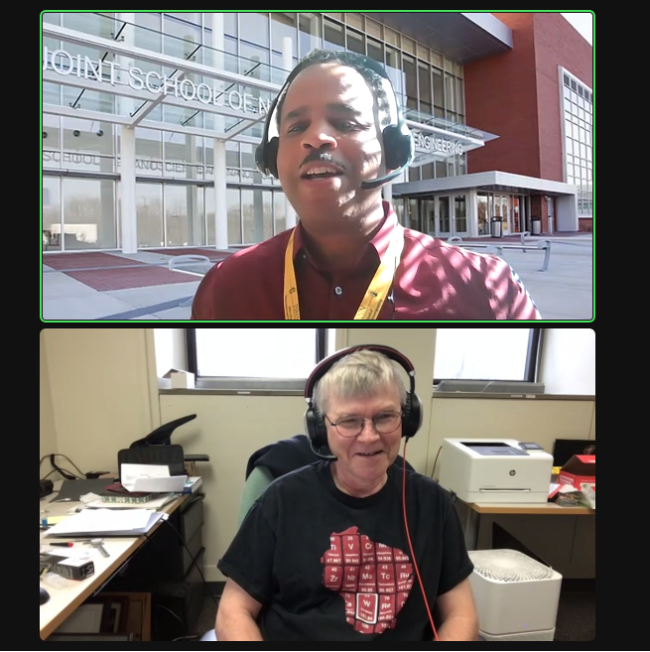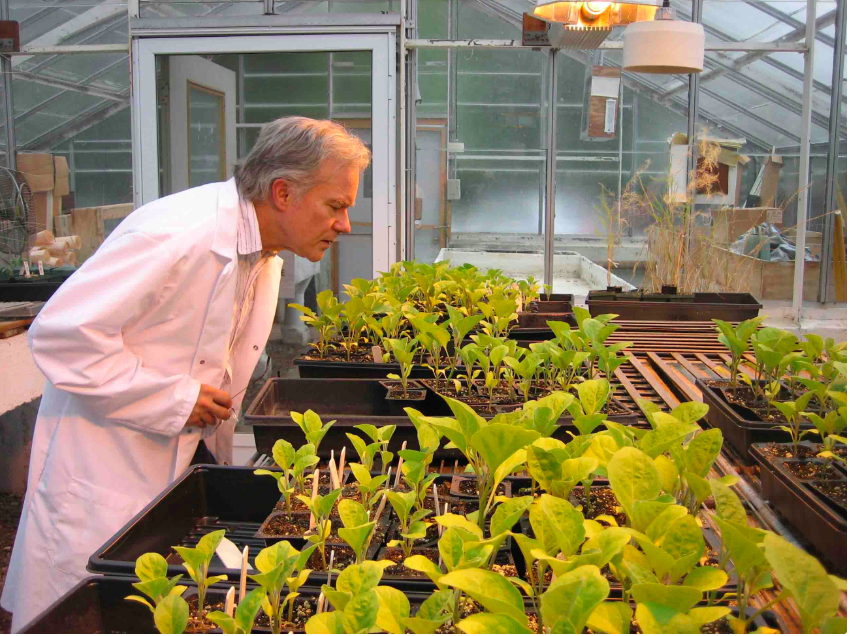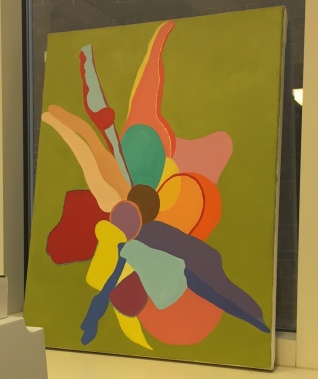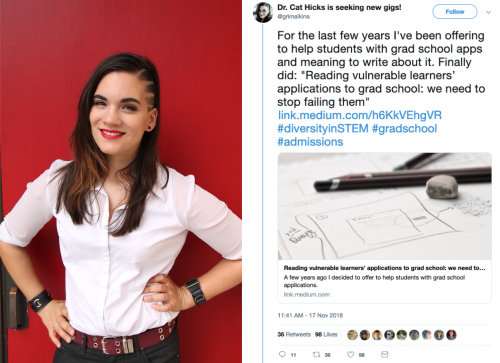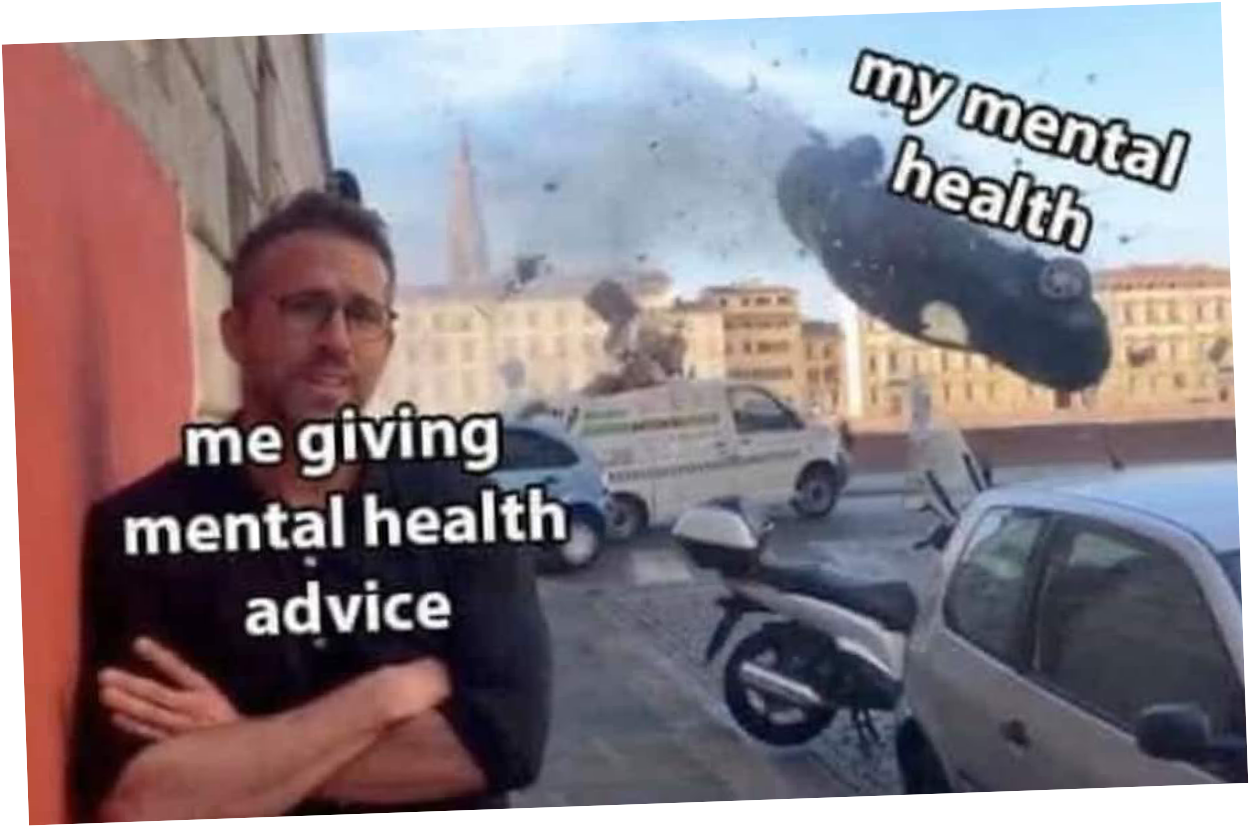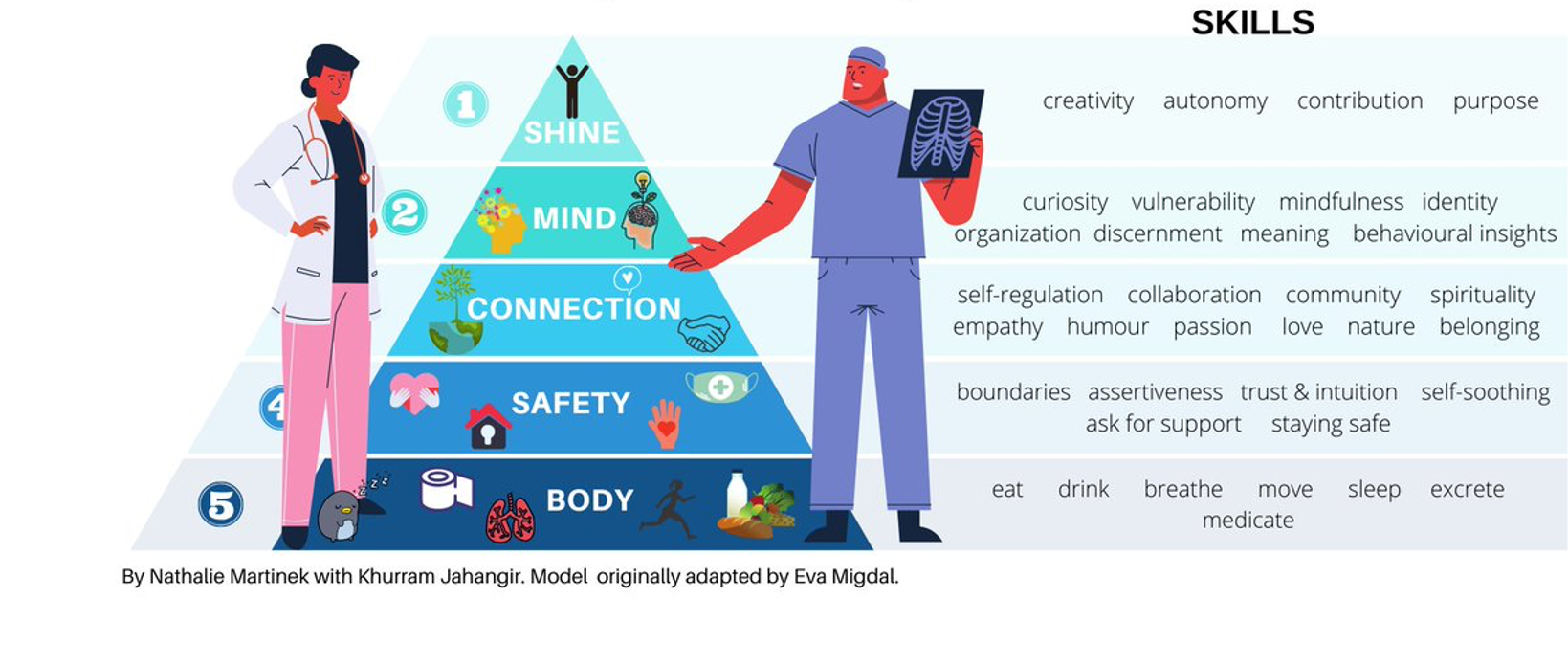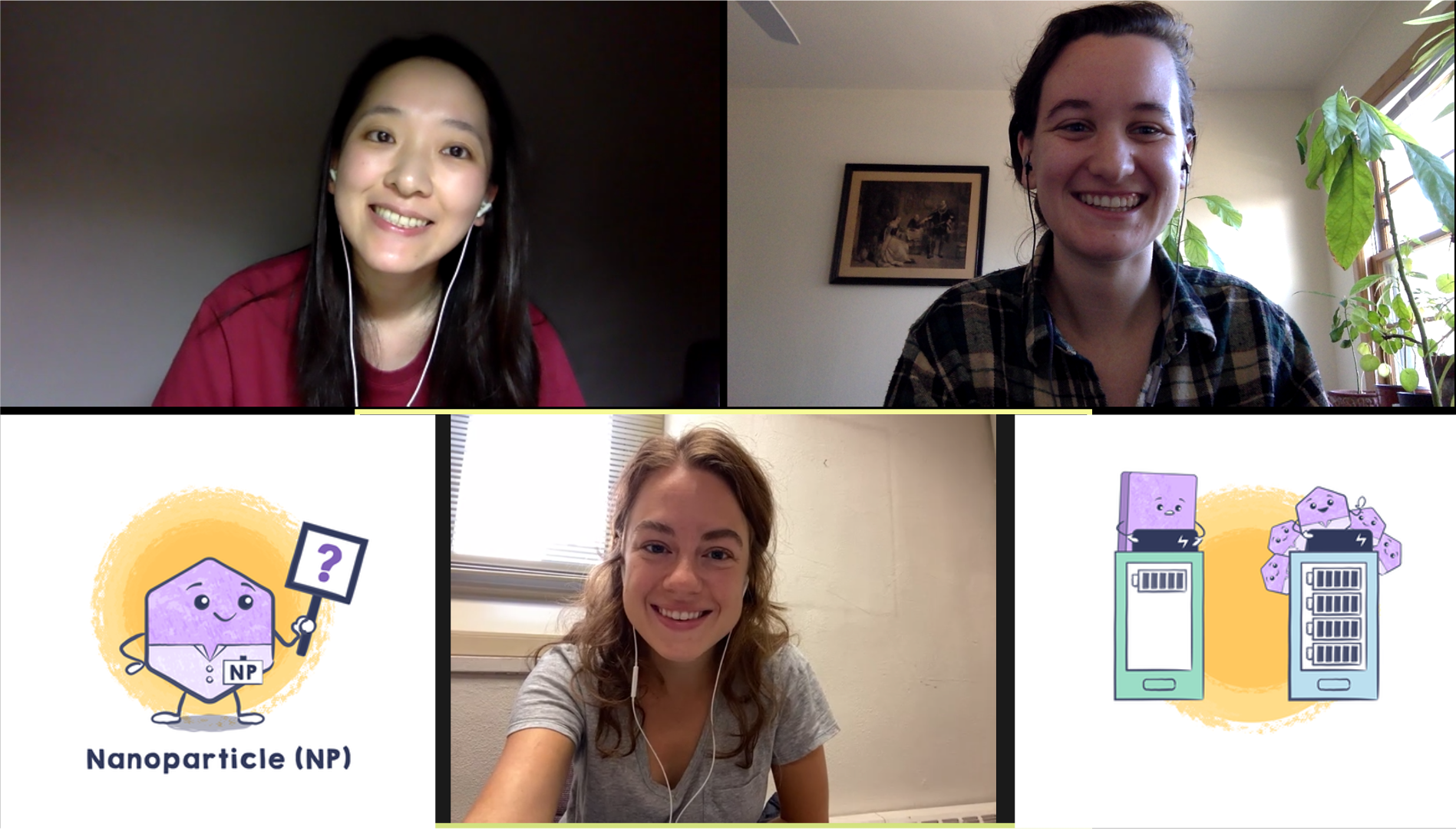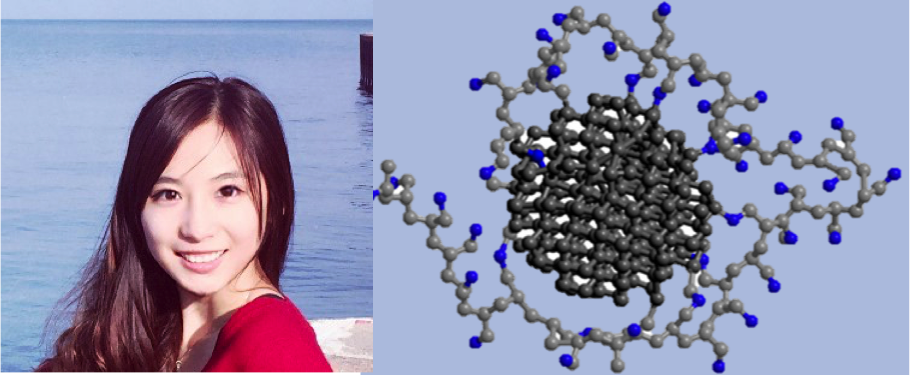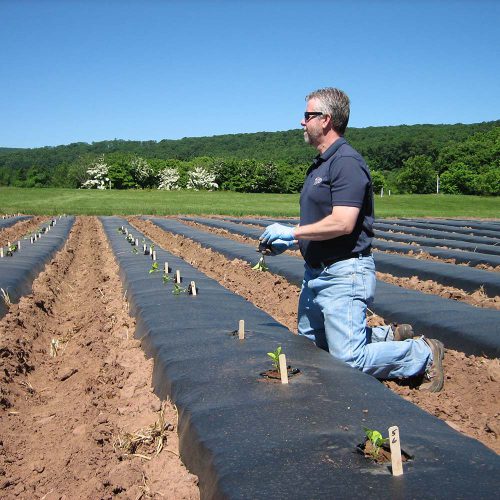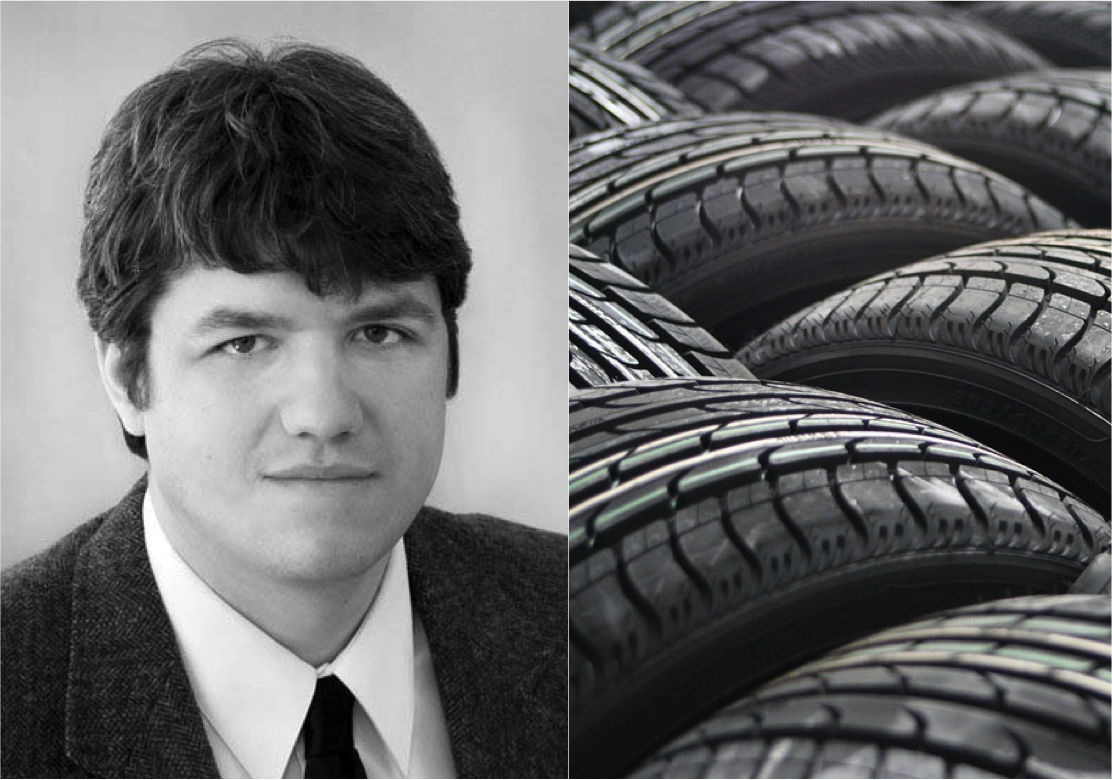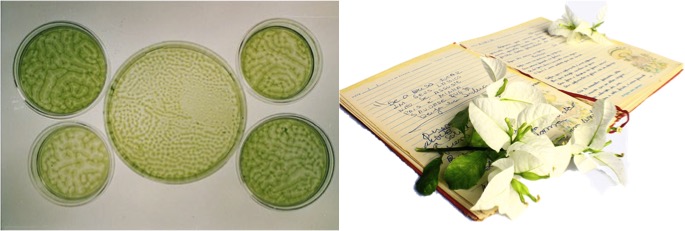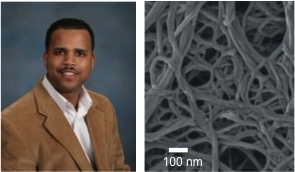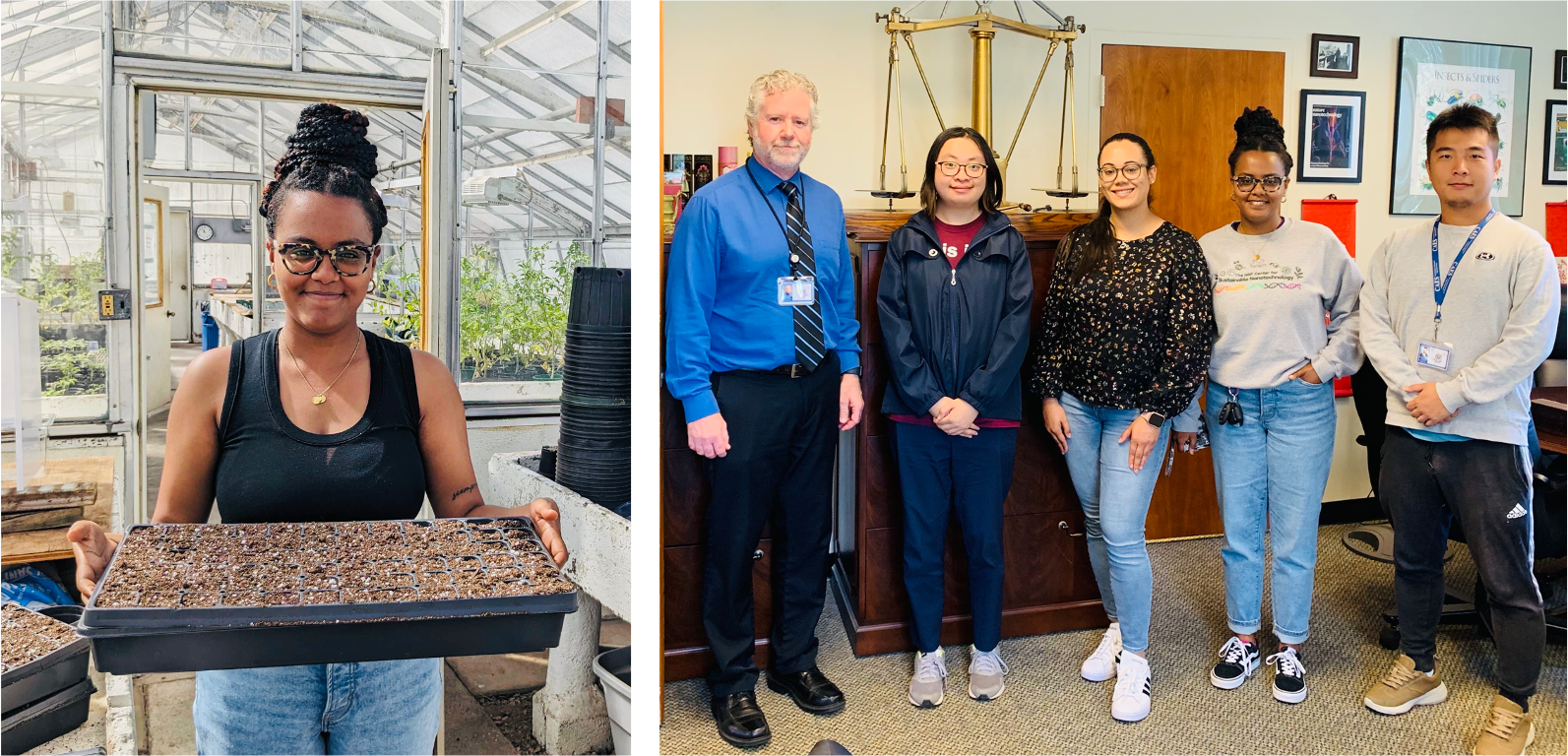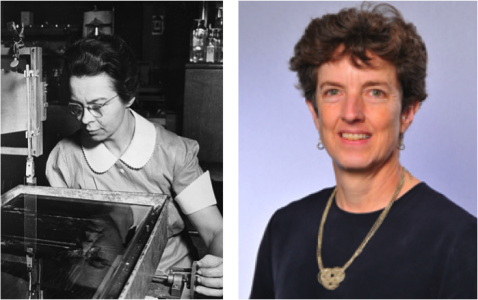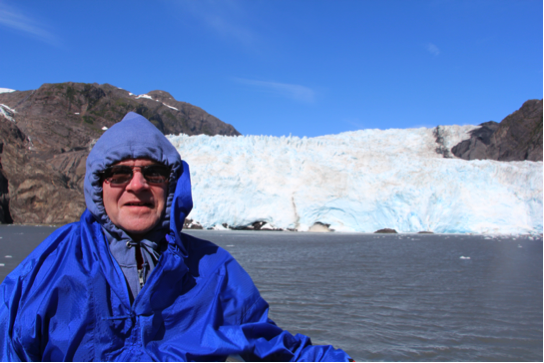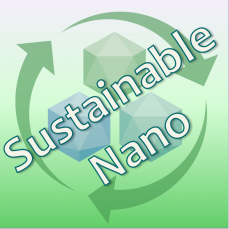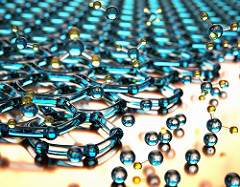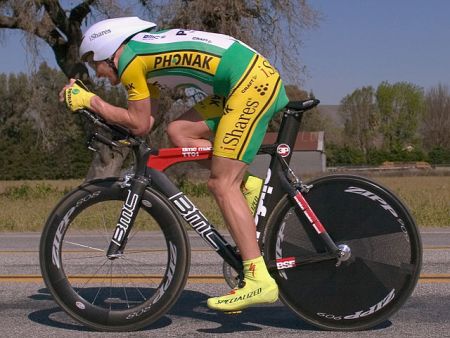
Sustainable Nano (Center for Sustainable Nanotechnology, Elfy Chiang)
Explorez tous les épisodes de Sustainable Nano
| Date | Titre | Durée | |
|---|---|---|---|
| 20 Dec 2019 | Ep. 34 Winter Holiday Mini-Episode: Colorful Carbon Dots | 00:08:19 | |
Winter can get pretty dark, especially in northern latitudes, and many cultures have winter holidays that feature and celebrate lights. For our last episode of 2019 we decided to talk about the bright and colorful chemistry of carbon dots! In this mini episode we interview Dr. Christy Haynes, Professor of Chemistry at the University of Minnesota and Associate Director of the Center for Sustainable Nanotechnology. 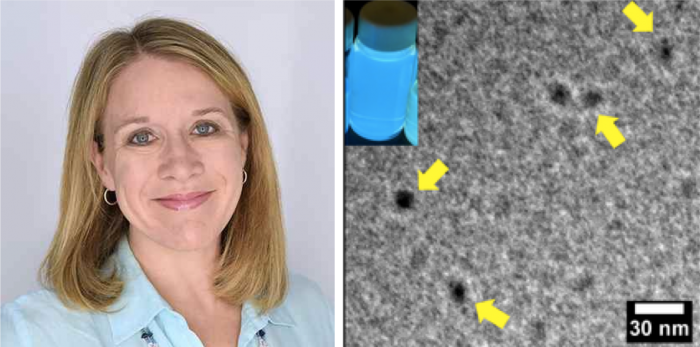 Left: Dr. Christy Haynes. Right: Transmission electron microscopy (TEM) image of malic acid carbon dots with an inset photo of the carbon dots in aqueous solution and illuminated by 365 nm UV (carbon dot image by Bo Zhi) Want more podcast episodes? You can find them all on our podcast page, or you can subscribe through Apple Podcasts or Stitcher. ABOUT THIS EPISODE Related links:
Interviewee: Christy Haynes Producer/Host: Miriam Krause Music: PC III and Dexter Britain  This material is based upon work supported by the National Science Foundation under the Center for Sustainable Nanotechnology, grant number CHE-1503408. Any opinions, findings, and conclusions or recommendations expressed on this podcast are those of the participants and do not necessarily reflect the views of the National Science Foundation or the participating institutions. | |||
| 09 Oct 2018 | Season 3 Preview | 00:02:06 | |
It's Season 3 of the Sustainable Nano Podcast! Here's a quick preview of a few of our upcoming episodes, including interviews with Dr. Mary Kirchhoff, Alvin Chang, & Dr. Jillian Buriak.
Sustainable Nano Season 3 is on the way! Want more podcast episodes? You can find them all on our podcast page, or you can subscribe through Apple Podcasts or Stitcher. #### **ABOUT THIS EPISODE** Related links: Producer/Host: Miriam Krause Music: PC III | |||
| 30 Oct 2019 | Ep 32. An Electronic Circuit on Every Seed? | 00:36:02 | |
What if every seed you planted could include a sensor to monitor moisture and nutrients? What if every tissue had nanoscale electronics to check for viruses when you blew your nose? Our fourth season launches with an interview about the future of nanotransistor technology with Professor Mike Filler from Georgia Tech. We also begin our new series of timely mini-interviews with a quick conversation about "necrochemistry" in honor of Halloween.  Prof. Michael Filler (left, photo courtesy of Dr. Filler) and his Nanovation Podcast Want more podcast episodes? You can find them all on our podcast page, or you can subscribe through Apple Podcasts or Stitcher. #### **ABOUT THIS EPISODE** Related links:
Interviewees: Mike Filler & Natalie Hudson-Smith Producer/Host: Miriam Krause Music: PC III and Dexter Britain  This material is based upon work supported by the National Science Foundation under the Center for Sustainable Nanotechnology, grant number CHE-1503408. Any opinions, findings, and conclusions or recommendations expressed on this podcast are those of the participants and do not necessarily reflect the views of the National Science Foundation or the participating institutions. | |||
| 22 Feb 2019 | Ep 30. Nanocomposites: Getting the Best of Two Worlds | 00:25:55 | |
What could be cooler than a technology that uses nanomaterials? How about one that combines two nanomaterials! Nanocomposites bring together two or more nanoscale materials to take advantage of their combined features to get what Dr. Klaus Müllen calls "the best out of two worlds." Dr. Müllen is an emeritus director at the Max Planck Institute for Polymer Research, where his work ranges from the chemistry and physics of small molecules to nanocomposites and biosynthetic hybrids. In this interview he talks about how a fascination with color got him into chemistry, some of the many technological applications for nanocomposites, and some candid advice for young scientists.
(L-R) Stephanie Mitchell, Dr. Klaus Müllen, and Andrew Northwick after their interview Want more podcast episodes? You can find them all on our podcast page, or you can subscribe through Apple Podcasts or Stitcher. #### **ABOUT THIS EPISODE** Related links:
Interviewee: Klaus Müllen Interviewers: Stephanie Mitchell & Andrew Northwick Producer/Host: Miriam Krause Music: PC III and Dexter Britain | |||
| 08 Feb 2018 | Ep 23. From Worm Genetics to Chocolate Cake: Art and Science with Dr. Ahna Skop | 00:30:19 | |
What does food blogging have to do with genetics research? In this episode, we talk with Dr. Ahna Skop, an associate professor of Genetics at the University of Wisconsin-Madison, about how art, science, and cooking intersect, as well as some of the benefits and challenges she has experienced being dyslexic.
Want more podcast episodes? You can find them all on our podcast page, or you can subscribe on iTunes or Stitcher.
C. Elegans artwork in the style of Miro (image courtesy of Ahna Skop) #### **ABOUT THIS EPISODE** Related links:
Interviewee: Dr. Ahna Skop Producer/Host: Miriam Krause Music: Ketsa | |||
| 06 Dec 2016 | Ep 10. Why Were Plastic Mirobeads Banned? Marine Debris and Sustainable Plastics | 00:19:33 | |
Plastic debris in our water is a huge pollution problem, and just one source of that pollution is the tiny microbeads that have been widely used in personal care products. In this episode of the podcast, we interview Dr. Richard Thompson, a Professor of Marine Biology at Plymouth University and an expert on the effects of plastic debris in the marine environment. We discuss the recent federal ban on microbeads and what consumers can do to be more sustainable in our day-to-day use of plastics.
Want more podcast episodes? You can find them all on our podcast page, or you can subscribe on iTunes or Stitcher. You can also find us on the National Science Foundation's Science360 Radio network. ABOUT THIS EPISODERelated links :
Interviewee: Prof. Richard Producers/Narrators: Miriam Krause and Stephanie Mitchell Music source: Music by Ketsa | |||
| 22 Oct 2021 | Ep 40. This Is the Future | 00:28:47 | |
It's the first episode of season 6! Come for the nanopharmacology, stay for the robotics and fun with Twitter networking. In this episode, we interview Olivia Geneus and Jarriaun Streets about founding #BlackinNanotech, how they got into science, and the challenges of communicating about nanotechnology. 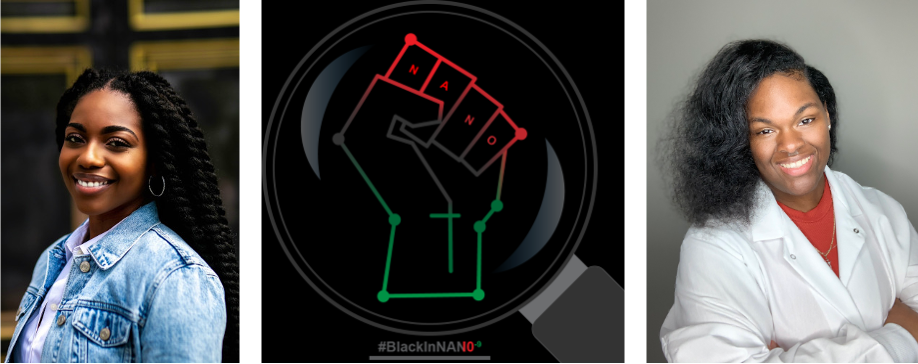 Black in Nanotech founders Olivia Geneus (left) and Jarriaun Streets (right), along with the #BlackInNano logo Want more podcast episodes? You can find them all on our podcast page, or you can subscribe through Apple Podcasts or Stitcher, or listen on NSF's Science Zone Radio. ABOUT THIS EPISODE
Interviewees: Jarriaun Streets & Olivia Geneus Interviewer: Beza Tuga Producer/Host: Miriam Krause Music: PC III and Dexter Britain  This material is based upon work supported by the National Science Foundation under the Center for Sustainable Nanotechnology, grant number CHE-2001611. Any opinions, findings, and conclusions or recommendations expressed on this podcast are those of the participants and do not necessarily reflect the views of the National Science Foundation or the participating institutions. | |||
| 15 Mar 2024 | Ep 45. The World is Really Ready for Change | 00:37:11 | |
Professor Mike Curry of the North Carolina Agricultural & Technological State University (NCAT) is a scientist, inventor, mentor, and advocate with a passion for bringing attention to the great research that happens at Historically Black Colleges & Universities (HBCUs). In this episode we share an interview between Dr. Curry and Dr. Bob Hamers, Director of the NSF Center for Sustainable Nanotechnology, discussing Dr. Curry's nanocellulose research and the process of bringing HBCUs and Primarily White Institutions (PWIs) together for meaningful collaboration.
image shows Mike Curry (above) and Bob Hamers (below) during their Zoom call to record this interview Want more podcast episodes? You can find them all on our podcast page, or you can subscribe through Apple Podcasts or Overcast, or listen on NSF's Science Zone Radio. ABOUT THIS EPISODE
Interviewee: Mike Curry Interviewer: Bob Hamers Producer/Host: Miriam Krause Music: PC III and Dexter Britain
This material is based upon work supported by the National Science Foundation under the Center for Sustainable Nanotechnology, grant number CHE-2001611. Any opinions, findings, and conclusions or recommendations expressed on this podcast are those of the participants and do not necessarily reflect the views of the National Science Foundation or the participating institutions. | |||
| 08 Mar 2023 | Ep 41. Stronger, Tougher, Lighter | 00:27:45 | |
What do nanotechnology, blacksmithing, and Star Wars have in common? In this episode, we talk with Dr. Suveen Mathaudhu about a range of topics from medical applications of materials science to metallurgy in The Mandalorian.  Zoom screen shot of Dr. Mathaudhu showing off his Armorer action figure (complete with her blacksmithing tools) Want more podcast episodes? You can find them all on our podcast page, or you can subscribe through Apple Podcasts or Stitcher, or listen on NSF's Science Zone Radio. ABOUT THIS EPISODE
Interviewee: Suveen Mathaudhu Producer/Host: Miriam Krause Editor: Jack Rahill Music: PC III and Dexter Britain  This material is based upon work supported by the National Science Foundation under the Center for Sustainable Nanotechnology, grant number CHE-2001611. Any opinions, findings, and conclusions or recommendations expressed on this podcast are those of the participants and do not necessarily reflect the views of the National Science Foundation or the participating institutions. | |||
| 28 Jun 2018 | Ep 25. Finding the Next Fix for the World's Problems: More from the Connecticut Agricultural Experiment Station | 00:23:00 | |
In the second interview from our visit to the Connecticut Agricultural Experiment Station, graduate students Natalie Hudson-Smith and Jaya Borgatta interview Dr. Wade Elmer, Chief Scientist for the Department of Plant Pathology and Ecology. They discuss everything from everyday garden fertilizers to cutting-edge nanoparticle experiments on watermelon.
Dr. Wade Elmer with eggplant seedlings at the Connecticut Agricultural Research Station. (image by Jan Ellen Spiegel, used with permission from Undark Magazine) Want more podcast episodes? You can find them all on our podcast page, or you can subscribe on iTunes or Stitcher. #### **ABOUT THIS EPISODE** Related links:
Interviewee: Dr. Wade Elmer Interviewers: Natalie Hudson-Smith and Jaya Borgatta Producer/Host: Miriam Krause Music: Ketsa | |||
| 20 Dec 2016 | Ep 11. When Artists and Scientists Collaborate | 00:18:20 | |
Art and science are often though of as completely separate pursuits, but what happens when artists and scientists actually talk to each other? In this episode of the podcast, we interview Dr. Cathy Murphy about her experiences inviting art students to spend time in her chemistry lab at the University of Illinois Urbana-Champaign.
Painting by Leah Guadagnoli, inspired by nanocrystal waste! (courtesy of Cathy Murphy) Some housekeeping news: Over the winter break, we will be moving the podcast to a new host. We'll still link to each episode here on the blog, and we hope there will be minimal (or zero!) disruption for listeners. However, if you subscribe to the podcast on iTunes, there is a chance you will need to re-subscribe next month. We'll post updates as we find out more! Meanwhile if you're want to catch up on earlier podcast episodes, you can find them all on our podcast page, or you can subscribe on iTunes or Stitcher. You can also find us on the National Science Foundation's Science360 Radio network. ABOUT THIS EPISODERelated links:
Interviewee: Prof. Cathy Murphy Producer/Narrator: Miriam Krause Music: Ketsa | |||
| 05 Oct 2017 | Ep 18. Why Do We Care About Emerging Contaminants? | 00:17:29 | |
As the Director of the Great Lakes Genomics Center in the School of Freshwater Sciences at the University of Wisconsin-Milwaukee, Professor Rebecca Klaper researches emerging contaminants such as nanomaterials and pharmaceuticals and how they affect freshwater organisms. In this episode we interview Dr. Klaper about the future of emerging contaminants and how her work relates to the development of sustainable nanomaterials.
(L: Rebecca Klaper is the Director of the Great Lakes Genomics Center in the School of Freshwater Sciences at the University of Wisconsin-Milwaukee. R: Zebrafish are often used in toxicology research (image from Oregon State University.) Want more podcast episodes? You can find them all on our podcast page, or you can subscribe on iTunes or Stitcher. #### **ABOUT THIS EPISODE** Related links:
Interviewee: Professor Rebecca Klaper Interviewers: Natalie Hudson-Smith and Jaya Borgatta Producer/Host: Miriam Krause Music: Ketsa | |||
| 29 Oct 2019 | Season 4 Preview | 00:01:27 | |
We've got a great lineup of episodes taking shape for this year on our themes of Nanotechnology, Sustainability, and Life in Science. Interviews include Prof. Mike Filler talking about nanowires and his podcast Nanovation, Majel Baker discussing the effects of sexism in science, Felice Frankel talking about visual communication for nanoscience, and that's only the beginning. Subscribe now so you don't miss an episode! | |||
| 27 Jun 2023 | Season 6 Trailer | 00:02:28 | |
We've got a great set of episodes for Season 6 following our themes of Nanotechnology, Sustainability, and Life in Science. Interviews include the founders of @BlackinNanotech, Dr. Olivia Geneus and Jarriaun Streets; materials scientist Dr. Suveen Mathaudhu; and psychiatrist Dr. Kaz Nelson, plus others! Subscribe now so you won't miss an episode. | |||
| 06 Oct 2020 | Ep 37. Shine Bright like a Diamond... Inside of a Worm | 00:17:53 | |
Zach Jones, a graduate student in the Center for Sustainable Nanotechnology, gives diamonds to his study organism. But they're nanodiamonds, not jewelry, and after the tiny worms eat them, Zack uses their fluorescent and magnetic properties to see where the material accumulates within the worm's body. This episode talks about worms, defective diamonds, and how the combination of the two can provide information on environmental contamination.  Zack Jones (left) and Paige Kinsley (right) recording this episode's interview (photos courtesy of Zack Jones and Paige Kinsley) Want more podcast episodes? You can find them all on our podcast page, or you can subscribe through Apple Podcasts or Stitcher, or listen on NSF's Science Zone Radio. ABOUT THIS EPISODE  Diagram of a nanodiamond molecule showing a nitrogen vacancy center defect (missing nitrogen atom) in the middle (image by Zack Jones) Related links:
Interviewee: Zack Jones Interviewer: Paige Kinsley Producer/Host: Miriam Krause Assistant Producer: Emma Bublitz Music: PC III and Dexter Britain  This material is based upon work supported by the National Science Foundation under the Center for Sustainable Nanotechnology, grant number CHE-2001611. Any opinions, findings, and conclusions or recommendations expressed on this podcast are those of the participants and do not necessarily reflect the views of the National Science Foundation or the participating institutions. | |||
| 22 Mar 2019 | Ep 31. Jumping Asteroid Clouds: Supporting Vulnerable Learners in Educational Achievement | 00:48:12 | |
Last November, Dr. Cat Hicks wrote an essay on Medium called "Reading vulnerable learners' applications to grad school: we need to stop failing them." In this episode of the podcast, University of Minnesota graduate student Becky Rodriguez interviews Dr. Hicks about her essay, her educational and career path, and how our educational system can be stacked against vulnerable learners. She offers some advice for applicants, those who review applications, and others who may just want to help. "A truly inclusive and diverse future will produce way better work, and you only get there by saying, 'we have to be comfortable with letting people be different.'" Our conversation is especially relevant given recent news and discussion about unfairness and fraud in U.S. college admissions. (And if you want to know what any of this has to do with asteroid fields, you'll just have to listen to the episode.)
Dr. Cat Hicks (left, photo courtesy of Dr. Hicks) and a tweet about her Medium essay on helping students with grad school applications Want more podcast episodes? You can find them all on our podcast page, or you can subscribe through Apple Podcasts or Stitcher. #### **ABOUT THIS EPISODE** Related links:
Interviewee: Cat Hicks Producer/Host: Miriam Krause Interviewer: Becky Rodriguez Music: PC III and Dexter Britain | |||
| 02 Nov 2018 | Ep 27. The Constant Loop: How Nanoparticles and the Environment Affect Each Other | 00:21:24 | |
Lithium Cobalt Oxide (LCO) is an important nanomaterial used in batteries, but little is known about what happens when it gets exposed to the environment. In this episode we interview Center for Sustainable Nanotechnology graduate student Liz Laudadio, who was the first author on a recent paper about what happens to LCO when it gets exposed to phosphates in water. We discuss why phosphates are important and next steps to understanding potential environmental impacts of nanomaterials: "It's a constant loop of, How do nanoparticles affect the environment? How does the environment affect nanoparticles?"
Left: Liz Laudadio working with an X-ray photoelectron spectrometer (XPS), which was used in this study to quantify how much phosphate adsorbed to LCO nanoparticles. Center/Right: Transmission Electron Microscope images of LCO nanosheets (from Laudadio et al. 2018, used with permission from the American Chemical Society) Want more podcast episodes? You can find them all on our podcast page, or you can subscribe through Apple Podcasts or Stitcher. #### **ABOUT THIS EPISODE** Related links:
Interviewee: Liz Laudadio Producer/Host: Miriam Krause Music: PC III and Dexter Britain | |||
| 26 Nov 2019 | Ep. 33 It Just Didn't Feel Like Me: Belonging and Sexism in Science | 00:48:09 | |
How often do college women in STEM (science, technology, engineering, and math) experience sexism? And how do these experiences affect their likelihood of staying in scientific fields? In this episode we talk with Majel Baker, a counseling psychologist who investigated these questions in her doctoral dissertation. Spoiler alert: sexism is bad. But there are ways we can work to improve the situation. Plus, we have a mini-interview about what this year's chemistry Nobel prize had to do with sustainable nanotechnology. 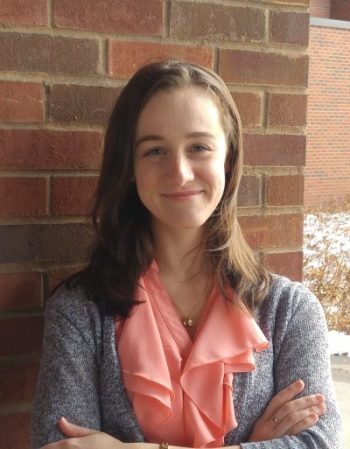 (photo courtesy of Majel Baker) Want more podcast episodes? You can find them all on our podcast page, or you can subscribe through Apple Podcasts or Stitcher. ABOUT THIS EPISODE Related links:
Interviewees: Majel Baker & Liz Laudadio Interviewer: Natalie Hudson-Smith Producer/Host: Miriam Krause Music: PC III and Dexter Britain Note: This episode description was edited on Nov 27, 2019 to reflect the fact that Majel Baker has not yet received her PhD. Although she has successfully defended her doctoral dissertation, we're still not allowed to call her "Dr. Baker" quite yet.  This material is based upon work supported by the National Science Foundation under the Center for Sustainable Nanotechnology, grant number CHE-1503408. Any opinions, findings, and conclusions or recommendations expressed on this podcast are those of the participants and do not necessarily reflect the views of the National Science Foundation or the participating institutions. | |||
| 03 Jul 2023 | Ep 42. Why We All Feel So Terrible And What to Do About It | 00:43:44 | |
Mental Health Awareness Month was back in May, but it's never too late to talk about mental health and strategies for taking care of ourselves during difficult times. In this episode we share a discussion with psychiatrist Dr. Kaz Nelson called "Why we all feel so terrible and what to do about it."
image shows a profile photo of Dr. Nelson Want more podcast episodes? You can find them all on our podcast page, or you can subscribe through Apple Podcasts or Stitcher, or listen on NSF's Science Zone Radio. ABOUT THIS EPISODE
Interviewee: Kaz Nelson Producer/Host: Miriam Krause Editor: Jack Rahill Music: PC III and Dexter Britain
This material is based upon work supported by the National Science Foundation under the Center for Sustainable Nanotechnology, grant number CHE-2001611. Any opinions, findings, and conclusions or recommendations expressed on this podcast are those of the participants and do not necessarily reflect the views of the National Science Foundation or the participating institutions. | |||
| 20 Aug 2020 | Ep 36. "Yes, and...": A Guide to Effective Science Communication Using Improvisation | 00:40:42 | |
Science communication takes a lot of different forms, including improvisation. In this episode, we interview Center for Sustainable Nanotechnology graduate student Paige Kinsley and alum Liz Laudadio. The episode dives deep into the life skills you can learn from doing improv, how it can make you a better listener, and how it relates to science storytelling. Not to mention the benefits of finding hobbies to do with your labmates.  (Paige Kinsley (left) and Liz Laudadio (right), mid-improv performance and recording this episode's interview, along with Blue the cat. (photos courtesy of Liz Laudadio & Paige Kinsley) Want more podcast episodes? You can find them all on our podcast page, or you can subscribe through Apple Podcasts or Stitcher, or listen on NSF's Science Zone Radio.
ABOUT THIS EPISODE Related links:
Interviewees: Liz Laudadio & Paige Kinsley Interviewer/Editor: Stephanie Mitchell Producer/Host: Miriam Krause Assistant Producer: Emma Bublitz Music: PC III and Dexter Britain  This material is based upon work supported by the National Science Foundation under the Center for Sustainable Nanotechnology, grant number CHE-1503408. Any opinions, findings, and conclusions or recommendations expressed on this podcast are those of the participants and do not necessarily reflect the views of the National Science Foundation or the participating institutions. | |||
| 09 Jan 2019 | Ep 29. Green is the Color of Chemistry | 00:21:12 | |
Dr. Mary Kirchhoff is Executive Vice President of Scientific Advancement at the American Chemical Society and Director of the ACS Green Chemistry Institute. Her career has spanned a variety of experiences related to sustainability in chemistry, including working with the U.S. Environmental Protection Agency's green chemistry program and co-editing a book on Greener Approaches to Undergraduate Chemistry Experiments. In this episode, Dr. Kirchhoff shares insights and examples on the importance of green chemistry with two graduate student interviewers from the Center for Sustainable Nanotechnology.
Dr. Mary Kirchhoff, Executive Vice President of Scientific Advancement at ACS (left); green chemistry image by IO-images Want more podcast episodes? You can find them all on our podcast page, or you can subscribe through Apple Podcasts or Stitcher. #### **ABOUT THIS EPISODE** Related links:
Interviewee: Mary Kirchhoff Interviewers: Stephanie Mitchell & Peter Clement Producer/Host: Miriam Krause Editor: Alicia McGeachy Music: PC III and Dexter Britain | |||
| 31 Mar 2017 | Ep 15. The Art of Beehives, Foam, & Bubbles: An Interview with Peter Krsko | 00:27:20 | |
Artist Peter Krsko uses his background in physics and materials science to study and communicate about nature. He is described as a "bioinspired artist whose approach combines science and art, participatory, interactive and community arts, and play with hands-on education." On this episode of the podcast, we interview Dr. Krsko about art, science, community building, and spending this semester as Artist in Residence at the UW-Madison Arts Institute's Interdisciplinary Arts Residency Program.
(images courtesy of Peter Krsko) Want more podcast episodes? You can find them all on our podcast page, or you can subscribe on iTunes or Stitcher. #### **MORE PHOTOS (all courtesy of Peter Krsko)**  Students (left) working on understanding the cone geometry of bergamot seeds (right)
A model of a sculpture (left) inspired by the structural colors of peacock feathers (right)
Community involvement in painting a mural #### **ABOUT THIS EPISODE** Related links:
Interviewee: Dr. Peter Krsko Producer/Host: Miriam Krause Music: Ketsa | |||
| 12 Jan 2021 | Ep 39. Retelling a Story Through Illustrations: Lifeology Part 2 | 00:51:57 | |
How do you explain sustainable nanotechnology using art? Last fall the Center for Sustainable Nanotechnology collaborated with Lifeology, an online platform that connects scientists and artists, to create a public-friendly "mini-course" called "What happens to nanoparticles in the environment?". On this episode of the podcast, CSN graduate students and course co-authors Stephanie Mitchell and Paige Kinsley talk with artist Elfy Chiang about her journey as an artist, working with scientists, and the excitement that can happen when collaborators surprise each other.
Artist Elfy Chiang (top left) and interviewers Paige Kinsley (top right) and Stephanie Mitchell (bottom) along with two examples of Elfy's artwork from "What happens to nanoparticles in the environment?" Want more podcast episodes? You can find them all on our podcast page, or you can subscribe through Apple Podcasts or Stitcher, or listen on NSF's Science Zone Radio. ABOUT THIS EPISODE
Cartoon nanoparticle from the Center for Sustainable Nanotechnology's Lifeology course, "What happens to nanoparticles in the environment?" (image by Elfy Chiang) Related links:
Interviewee: Elfy Chiang Interviewers: Stephanie Mitchell & Paige Kinsley Producer/Host: Miriam Krause Music: PC III and Dexter Britain
This material is based upon work supported by the National Science Foundation under the Center for Sustainable Nanotechnology, grant number CHE-2001611. Any opinions, findings, and conclusions or recommendations expressed on this podcast are those of the participants and do not necessarily reflect the views of the National Science Foundation or the participating institutions. | |||
| 16 Apr 2018 | Ep 24. Using MRI technology to study nanoparticles | 00:23:13 | |
How do we "see" nanoparticles when they're too small to view with a normal microscope? In this episode we interview Kelly Zhang, a graduate student in the Center for Sustainable Nanotechnology who recently published a paper about a new way to use NMR technology (like MRI for chemistry) to study the behavior of molecules that form a shell on diamond nanoparticles. We also talk about how watching anime as a kid inspired Kelly to become a chemist.
Want more podcast episodes? You can find them all on our podcast page, on spotify, or you can subscribe on iTunes or Stitcher. #### **ABOUT THIS EPISODE** Related links:
Interviewee: Kelly Zhang Producer/Host: Miriam Krause Music: Ketsa and Dexter Britain | |||
| 03 Nov 2017 | Ep. 20 Dr. Gro Harlem Brundtland and the Definition of Sustainability | 00:32:29 | |
What does "sustainability" mean? Dr. Gro Harlem Brundtland is famous for serving three terms as the Prime Minister of Norway and chairing the World Commission on Environment and Development -- the Brundtland Commission -- which defined sustainable development as "development that meets the needs of the present without compromising the ability of future generations to meet their own needs." In this episode we discuss Dr. Brundtland's autobiography, Madam Prime Minister, her life and accomplishments, and her contribution to our modern understanding of sustainability.
(Dr. Brundtland at a conference in 2014 (image by Luiz Munhoz)) Want more podcast episodes? You can find them all on our podcast page, or you can subscribe on iTunes or Stitcher. #### **ABOUT THIS EPISODE** Related links:
Interviewee: Liz Laudadio Producer/Host: Miriam Krause Music: Ketsa | |||
| 24 Jan 2017 | Spring 2017 Teaser | 00:01:23 | |
We're back from winter break and preparing a fantastic batch of podcast episodes for spring 2017! Over the next few months we'll be featuring interviews with Dr. Hope Jahren and Dr. Mike Curry, plus a profile of Dr. Gro Harlem Brundtland, and much more. Stay tuned!
2017 is here! (image adapted from Vector Open Stock) | |||
| 22 Sep 2017 | Ep 17. Putting Science to Work for Society: A Visit to the Connecticut Agricultural Experiment Station | 00:30:01 | |
Chemistry at the Connecticut Agricultural Experiment Station ranges from testing how nanoparticles help plants grow to determining what kind of poison was placed in someone's coffee. In this episode, we interview Dr. Jason White, Vice Director of Analytical Chemistry at the CAES and our newest collaborator in the Center for Sustainable Nanotechnology.
(Dr. Jason White planting eggplants at the Connecticut Agricultural Research Station. (image by Jan Ellen Spiegel, used with permission from Undark Magazine)) Want more podcast episodes? You can find them all on our podcast page, or you can subscribe on iTunes or Stitcher. #### **ABOUT THIS EPISODE** Related links:
Interviewee: Dr. Jason White Interviewers: Natalie Hudson-Smith and Jaya Borgatta Producer/Host: Miriam Krause Music: Ketsa and Dexter Britain | |||
| 20 Dec 2023 | Ep 44. Part of Something Bigger: Social Media, Mentoring, & Friendship with Stuart Cantrill | 00:41:23 | |
Early in the COVID pandemic, then-graduate student Safia Jilani became Twitter buddies with the Chief Editor of the prestigious journal Nature Chemistry, Dr. Stuart Cantrill. Dr. Jilani is now a Postdoctoral Fellow with the NSF Center for Sustainable Nanotechnology, and Dr. Cantrill is now the Editorial Director for all of Nature's physics and chemistry journals... and they finally got the chance to meet in person last month! In this episode we bring you a conversation between these two chemists about the power and challenges of social media, the importance of mentorship, and being open to unforeseen career paths.  image shows Stuart Cantrill (left) and Safia Jilani (right) enjoying ice cream in Cambridge Want more podcast episodes? You can find them all on our podcast page, or you can subscribe through Apple Podcasts or Stitcher, or listen on NSF's Science Zone Radio. ABOUT THIS EPISODE
Interviewee: Stuart Cantrill Interviewer: Safia Jilani Producer/Host: Miriam Krause Music: PC III and Dexter Britain  This material is based upon work supported by the National Science Foundation under the Center for Sustainable Nanotechnology, grant number CHE-2001611. Any opinions, findings, and conclusions or recommendations expressed on this podcast are those of the participants and do not necessarily reflect the views of the National Science Foundation or the participating institutions. | |||
| 15 Mar 2017 | Ep 14. What Does Nanotechnology Have to Do With Renewable Car Tires? | 00:15:36 | |
What if car tires could be made from renewable resources instead of petroleum? In this episode of the podcast, we interview Dr. Paul Dauenhauer, part of a research team from the Center for Sustainable Polymers who have developed a new chemical process to make isoprene (one of the key ingredients in car tires) from biomass such as grass or corn.
(images from Paul Dauenhauer & Pixabay) Want more podcast episodes? You can find them all on our podcast page, or you can subscribe on iTunes or Stitcher. ABOUT THIS EPISODERelated links:
Interviewee: Prof. Paul Dauenhauer Producer/Host: Miriam Krause Music: Ketsa | |||
| 28 Feb 2017 | Ep 13. Communicating About Science with 'Lab Girl' Author Hope Jahren | 00:25:54 | |
Dr. Hope Jahren is a geobiologist who studies fossil organisms and the global environment, and is also the New York Times-bestelling author of the memoir Lab Girl. In this episode of the podcast, we interview Dr. Jahren about communicating science with the public, the joys and challenges of writing academic articles, and her thoughts on sexism in science.
(images by Andrea Kamphuis & Gadini) Want more podcast episodes? You can find them all on our podcast page, or you can subscribe on iTunes or Stitcher. ABOUT THIS EPISODERelated links:
Interviewee: Prof. Hope Jahren Interviewer: Natalie Hudson-Smith Producer/Host: Miriam Krause Music: Ketsa, Kai Engel, & Evgeny Grinko | |||
| 19 Oct 2018 | Ep 26. Nanomaterials and Renewable Energy: From Solar Panels to Machine Learning | 00:21:40 | |
How are photons like toddlers? And what does that have to do with solar energy? Dr. Jillian Buriak has been researching nanomaterials and renewable energy for over a decade, including work to improve solar panel technology. In this first episode of the Sustainable Nano Podcast's third season, we interview Dr. Buriak, who is a Professor of Chemistry at the University of Alberta and Canada Research Chair of Nanomaterials for Energy, about her research, career path, and even some advice for junior scientists.
Dr. Jillian Buriak (left) and the cover illustration of single-crystal nickel−iron oxide nanoparticles of different shapes, based on an article from her lab (right, from Bao et al. 2014. (used with permission from the American Chemical Society) Want more podcast episodes? You can find them all on our podcast page, or you can subscribe on iTunes or Stitcher. #### **ABOUT THIS EPISODE** Related links:
Interviewee: Dr. Jillian Buriak Producer/Host: Miriam Krause Editor: Alicia McGeachy Music: PC III | |||
| 19 May 2017 | Ep 16. Maybe Not the Next Industrial Revolution? Societal & Ethical Implications of Nanotechnology | 00:25:17 | |
A lot has changed in the last 10-15 years about our hopes and fears around nanotechnology. Ira Bennett and Jameson Wetmore are professors in the Center for Nanotechnology in Society at Arizona State University, and in this episode of the Sustainable Nano podcast we interview them about the complexities of understanding the ethical and societal implications of brand new innovations like nanotechnology.
(Dr. Ira Bennett, Dr. Jamey Wetmore, and the ASU Center for Nanotechnology in Society) Want more podcast episodes? You can find them all on our podcast page, or you can subscribe on iTunes or Stitcher. #### **ABOUT THIS EPISODE** Related links:
Interviewees: Dr. Ira Bennett & Dr. Jamey Wetmore Producer/Host: Miriam Krause Music: Ketsa | |||
| 30 Nov 2018 | Ep 28. Who's Not In the Room and Why Not? Inclusivity and Bias Across Class Backgrounds in College Education | 00:32:36 | |
Alvin Chang, Senior Graphics Reporter for Vox, wrote and illustrated an article last year called "The subtle ways colleges discriminate against poor students, explained with a cartoon." In this episode of the podcast, we share the audio of a webinar that Chang presented for the Center for Sustainable Nanotechnology about his work. He tackles challenging issues of class, bias, and educational attainment using clear illustrations (verbal as well as visual) and simple analogies that are relevant far beyond the world of academic science.
Alvin Chang, Senior Graphics Reporter for Vox (left, courtesy of Alvin Chang) and one of his illustrations for "The subtle ways colleges discriminate against poor students, explained with a cartoon" (right, used with permission from Vox.com) Want more podcast episodes? You can find them all on our podcast page, or you can subscribe through Apple Podcasts or Stitcher. #### **ABOUT THIS EPISODE** Related links:
Interviewee: Alvin Chang Producer/Host: Miriam Krause Audience Questions: Peter Clement, Nicholas Niemuth, Becky Rodriguez, & Rigoberto Hernandez Editor: Alicia McGeachy Music: PC III and Dexter Britain | |||
| 20 Oct 2017 | Ep. 19 Scientists and Impostor Syndrome: Can We Do Anything About It? | 00:29:41 | |
You may have heard of "impostor syndrome" or "imposter phenomenon," when perfectly competent people have the feeling that they don't belong or are faking it in their professional lives. It can lead sufferers to hold back their ideas and self-reject from opportunities, and it is surprisingly common among high-achieving people. In this episode, we talk with Dr. Valerie Young, an expert on impostor syndrome with both research and personal experience. She discusses one common factor across all people who experience impostor syndrome, and three things you can do about it if you experience the phenomenon yourself.
(Dr. Valerie Young is an expert on imposter syndrome and an award-winning author.) Want more podcast episodes? You can find them all on our podcast page, or you can subscribe on iTunes or Stitcher. #### **ABOUT THIS EPISODE** Related links:
Interviewee: Dr. Valerie Young Producer/Host: Miriam Krause Music: Ketsa | |||
| 14 Feb 2017 | Ep 12. Making Sustainable Nanoparticles From Plants | 00:20:23 | |
Nanoparticles are widely used in a variety of technologies, and some researchers are looking for ways to make those nanoparticles more environmentally friendly. In this episode of the podcast, we interview Dr. Mike Curry about his research making nanoparticles from cellulose, a very common molecule found in plants.
Dr. Mike Curry and a network of cellulose nanofibers (nanocellulose image by Qspheroid4) Want more podcast episodes? You can find them all on our podcast page, or you can subscribe on iTunes or Stitcher. ABOUT THIS EPISODERelated links:
Interviewee: Prof. Mike Curry Producer/Host: Miriam Krause Music: Ketsa | |||
| 07 Nov 2023 | Ep 43. Revolutionizing How we Grow, Distribute, & Store Food: Revisiting the Connecticut Agricultural Experiment Station | 00:42:50 | |
Five years after our first interview, we catch up with Dr. Jason White about chemistry at the Connecticut Agricultural Experiment Station and how nanoscience can benefit agriculture and global food security. Graduate student Beza Tuga interviews Jason about his new role as Director of CAES and exciting research collaborations between CAES and the NSF Center for Sustainable Nanotechnology.
image shows Beza Tuga (left) and the CSN team in Jason's office (L-R Jason White, Cheng-Hsin Huang, Wilanyi Alvarez Reyes, Beza Tuga, & Chaoyi Deng) Want more podcast episodes? You can find them all on our podcast page, or you can subscribe through Apple Podcasts or Stitcher, or listen on NSF's Science Zone Radio. ABOUT THIS EPISODE
Interviewee: Jason White Interviewer: Beza Tuga Producer/Host: Miriam Krause Music: PC III and Dexter Britain
This material is based upon work supported by the National Science Foundation under the Center for Sustainable Nanotechnology, grant number CHE-2001611. Any opinions, findings, and conclusions or recommendations expressed on this podcast are those of the participants and do not necessarily reflect the views of the National Science Foundation or the participating institutions. | |||
| 20 Dec 2017 | Ep 22. On Thin Films and Nobel Prizes: Margaret Schott Profiles Katharine Burr Blodgett | 00:24:03 | |
At last summer's American Chemical Society national meeting, Dr. Margaret Schott of Northwestern University took the unusual step of giving her history division presentation as her subject, Dr. Katharine Burr Blodgett. In this episode we interview Dr. Schott about her own path in life and chemistry, as well as that of Dr. Blodgett, including the debate about whether this pioneer of thin film technology was overlooked for a Nobel Prize.
(Katharine Burr Blodgett (left, image from the Smithsonian) and Margaret Schott (right, image from Northwestern University)) Want more podcast episodes? You can find them all on our podcast page, or you can subscribe on iTunes or Stitcher. #### **ABOUT THIS EPISODE** Related links:
Interviewee: Dr. Margaret Schott Interviewer: Liz Laudadio Producer/Host: Miriam Krause Music: Ketsa | |||
| 08 May 2020 | Ep. 35 Photographing the Unphotographable | 00:37:23 | |
How do you photograph the unphotographable? In this episode we interview MIT research scientist Felice Frankel, who specializes in visualizing science, using pictures to draw audiences in and help scientists more deeply examine their own work, including nanoscale materials that are smaller than wavelengths of light! We also have a mini-interview with graduate student Paige Kinsley about how COVID-19 is affecting chemistry labs in the Center for Sustainable Nanotechnology.  (photos by Miriam Krause) Want more podcast episodes? You can find them all on our podcast page, or you can subscribe through Apple Podcasts or Stitcher. ABOUT THIS EPISODE Related links:
Interviewees: Felice Frankel & Paige Kinsley Interviewer: Stephanie Mitchell Editor: Natalie Hudson-Smith Producer/Host: Miriam Krause Music: PC III and Dexter Britain  This material is based upon work supported by the National Science Foundation under the Center for Sustainable Nanotechnology, grant number CHE-1503408. Any opinions, findings, and conclusions or recommendations expressed on this podcast are those of the participants and do not necessarily reflect the views of the National Science Foundation or the participating institutions. | |||
| 30 Nov 2017 | Ep 21. Quantifying Effects of Gender Bias: There's an App for That | 00:21:39 | |
Does gender bias matter? You can see for yourself thanks to an interactive app created by software engineer Penelope Hill at doesgenderbiasmatter.com. In this episode, we interview Penelope about what prompted her to create the app, some of the research behind it, and a few of the ways people in science and technology fields are working to overcome bias.
(Penelope Hill is the software engineer behind doesgenderbiasmatter.com.) Want more podcast episodes? You can find them all on our podcast page, or you can subscribe on iTunes or Stitcher. #### **ABOUT THIS EPISODE** Related links:
Interviewee: Penelope Hill Producer/Host: Miriam Krause Music: Ketsa | |||
| 28 Dec 2020 | Ep 38. Beyond Jargon to Empathy: Lifeology Part 1 | 00:42:23 | |
How do you explain sustainable nanotechnology in text shorter than a tweet? This fall the Center for Sustainable Nanotechnology collaborated with Lifeology, an online platform that connects scientists and artists, to create a public-friendly "mini-course" called "What happens to nanoparticles in the environment?". On this episode of the podcast, CSN graduate students and course co-authors Jaya Borgatta and Stephanie Mitchell talk with Lifeology co-founder Paige Jarreau about Lifeology, her journey to becoming a professional science communicator, and the importance of empathy in achieving accessible communication. 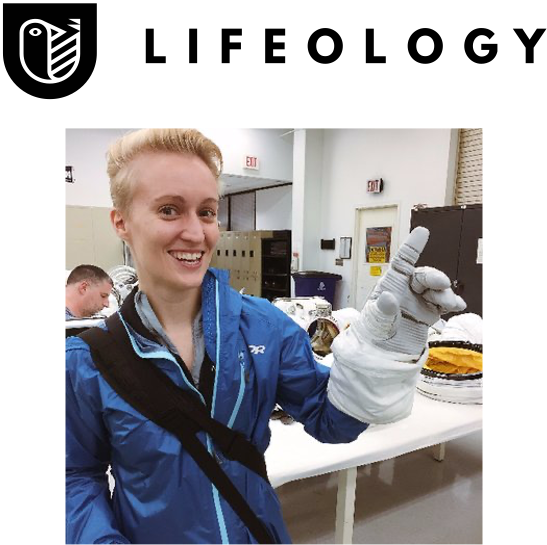 Paige Jarreau is the co-founder of Lifeology) Want more podcast episodes? You can find them all on our podcast page, or you can subscribe through Apple Podcasts or Stitcher, or listen on NSF's Science Zone Radio. ABOUT THIS EPISODE 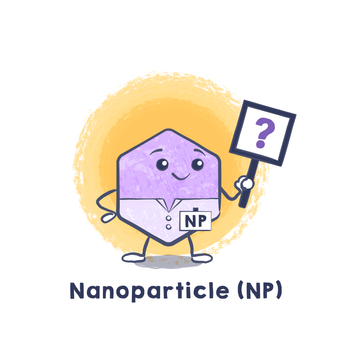 Cartoon nanoparticle from the Center for Sustainable Nanotechnology's Lifeology course, "What happens to nanoparticles in the environment?" (image by Elfy Chiang) Related links:
Interviewee: Paige Jarreau Interviewers: Stephanie Mitchell & Jaya Borgatta Producer/Host: Miriam Krause Music: PC III and Dexter Britain  This material is based upon work supported by the National Science Foundation under the Center for Sustainable Nanotechnology, grant number CHE-2001611. Any opinions, findings, and conclusions or recommendations expressed on this podcast are those of the participants and do not necessarily reflect the views of the National Science Foundation or the participating institutions. | |||
| 12 Sep 2016 | Ep 1. Why Do We Care About Sustainable Nanotechnology? | 00:18:05 | |
What does “Sustainable Nano” even mean? On this pilot episode of our brand new podcast, we talk with the Director of the Center for Sustainable Nanotechnology, along with students, faculty, and a few complete strangers about some questions related to our Center’s research: What is nanotechnology? What is sustainability? And what does it mean when we put the two terms together? https://sustainablenano.files.wordpress.com/2016/09/pilot-sept6-9616-4-40-pm.mp3
We’ll be posting new episodes of the podcast Monday through Thursday this week, so stay tuned! You can find each episode here on the blog or on our podcast page, or you can subscribe on iTunes. ABOUT THIS EPISODERelated links :
Interviewees : Dr. Bob Hamers, Dr. Christy Haynes, Dr. Zeev Rosenzweig, Dr. Rebecca Klaper, Dr. Ian Gunsolus, Andie Alton, Austin Hermann, Tamira Amin, Kyle Johnson, Maddy Meyer, Gus Millevolte, Jared Bozich Producer/Narrator : Dr. Miriam Krause **Music sources: ** Music for this episode came from the Free Music Archive, specifically tracks by Kesta and Dexter Britain Tagged: grants, nanotechnology, NSF, podcast, research, sustainability | |||
| 15 Sep 2016 | Ep 4. Nano Superheros: At the Interface of Art and Science | 00:26:18 | |
Welcome to episode 4 of the Sustainable Nano podcast! In this final new episode of our launch week, we interview the three high school student finalists from NSF’s Generation Nano contest about their amazing nanotechnology-based superheroes.
image credit: Vegas Bleeds Neon https://sustainablenano.files.wordpress.com/2016/09/generationnano.mp3
Stay tuned for future episodes coming every other week this fall. You can find them here on the blog, or subscribe on iTunes. ABOUT THIS EPISODERelated links :
Interviewees : Madeleine Chang, Eric Liu, Vuong Mai, Prof. Suveen Mathaudhu Producers/Narrators : Miriam Krause & Melissa Richardson **Music sources: ** Our music is by Ketsa (from the Free Music Archive) and sound effects are from ZapSplat. Tagged: art, generation nano, high school, nanotechnology, NSF, podcast, STEAM, STEM, superheroes | |||
| 14 Sep 2016 | Ep 3. Nanoparticles in Electric Car Batteries: How Do We Study Sustainability? | 00:26:11 | |
Welcome to episode 3 of the Sustainable Nano podcast! In this episode, we talk about a recent research study that looked at how one type of battery nanomaterial affects bacteria called Shewanella oneidensis. We interview Mimi Hang and Ian Gunsolus, who were co-first authors of the study as graduate students in the Center for Sustainable Nanotechnology.
The Nissan Leaf is one example of an electric car that uses NMC in its batteries (image by Tennen-Gas) https://sustainablenano.files.wordpress.com/2016/09/nmc-091416.mp3
The study may sound familiar to regular blog readers – Mimi summarized it in this post and it got some media attention, which we wrote about here and here. Wrapping up our podcast launch week we will have one more new episode coming tomorrow (nanotechnology superheroes!). After that we will switch to an every-other-week schedule. Be sure to subscribe on iTunes so you don’t miss an episode! Or if you’re not an iTunes person, you can always still listen here on the blog. ABOUT THIS EPISODERelated links :
Interviewees : Dr. Ian Gunsolus, Mimi Hang Producer/Narrator : Miriam Krause **Music sources: ** Music for this episode came from the Free Music Archive, specifically tracks by Kesta and Dexter Britain Tagged: bacteria, batteries, electric cars, nanotechnology, podcast, research, Shewanella oneidensis | |||
| 13 Sep 2016 | Ep 2. Viruses: Biology’s Nanoparticles | 00:19:22 | |
Welcome to episode 2 of the Sustainable Nano podcast! In this episode, we talk with scientist M.G. Finn about how viruses are like (and unlike) nanoparticles, and some of the ways researchers want to use viruses to fight disease.
A virus-like nanoparticle. (image adapted with permission from Pokorski et al. (2011), copyright American Chemical Society) https://sustainablenano.files.wordpress.com/2016/08/viruses-82516-4-57-pm.mp3
We still have two more new episodes coming up this week! You can listen to them here on the blog or through iTunes. ABOUT THIS EPISODERelated links :
Interviewee : Professor M.G. Finn Producer/Narrator : Miriam Krause **Music source: ** Music for this episode is by Kesta, acquired from the Free Music Archive Tagged: nanomedicine, nanoparticles, nanotechnology, podcast, viruses | |||
| 25 Oct 2016 | Ep 7. What Do Glaciers Have to Do With Nanoscience? | 00:16:04 | |
Why do glaciers sometimes look blue? Hint: it’s not for the same reason we see blue as the color of the sky! On this episode of the podcast, we have an interview with Dr. Robert Hamers, following up on his recent blog post. Bob is the Director of the Center for Sustainable Nanotechnology, and he tells us about a recent family trip to Alaska that got him wondering about why some glaciers have an amazing blue color.
CSN Director Bob Hamers in front of Holgate Glacier (photo by Bob Hamers) https://sustainablenano.files.wordpress.com/2016/10/whyglacierslookblue1.mp3
Stay tuned for more podcast episodes coming every other week this fall! You can find them all on our podcast page, or you can subscribe on iTunes or Stitcher. You can also find us on the National Science Foundation’s Science360 Radio network. ABOUT THIS EPISODERelated links :
Interviewee : Prof. Bob Hamers Producer/Narrator : Miriam Krause **Music sources: ** Music for this episode is by Ketsa and the violin sample came from the University of Iowa Electronic Music Studios Tagged: color, colors, glaciers, music, nano, podcast, wavelength | |||
| 22 Nov 2016 | Ep 9. Seven Stages of Technological Adaptation | 00:14:59 | |
This episode of the podcast features an interview with University of Minnesota graduate student Peter Clement, discussing the book The War on Science by Shawn Otto. We focus on Otto’s explanation of the Seven Stages of Technological Adaptation — an observation that how our society adapts new technology has generally repeated the same sequence of steps over and over, from discovery through crisis and adaptation, especially since the mid-20th Century.
(image from amazon.com) https://sustainablenano.files.wordpress.com/2016/11/bookreview-waronscience.mp3
Want more podcast episodes? You can find them all on our podcast page, or you can subscribe on iTunes or Stitcher. You can also find us on the National Science Foundation’s Science360 Radio network. ABOUT THIS EPISODERelated links :
Interviewee : Peter Clement Producer/Narrator : Miriam Krause **Music sources: ** Music by Ketsa **Disclaimer: ** This material is based upon work supported by the National Science Foundation under the Center for Sustainable Nanotechnology grant. Any opinions, findings, and conclusions or recommendations expressed on this podcast are those of the participants and do not necessarily reflect the views of the National Science Foundation or the participating institutions. Tagged: book review, nanotechnology, podcast, public policy, technology | |||
| 09 Sep 2016 | It’s the Sustainable Nano Podcast Preview! | 00:02:24 | |
That’s right, Sustainable Nano is about to become a podcast!
Podcast cover art! This new audio version of Sustainable Nano is launching next week. You can get a brief sample of what we have in store with this 3-minute preview episode: https://sustainablenano.files.wordpress.com/2016/09/preview-9916-9-20-am.mp3
Don’t worry, the Sustainable Nano blog that you know and love isn’t going anywhere! Although next week the blog will be dominated by podcast episodes, starting the week of September 19th we’ll resume our regular weekly(ish) schedule of written posts about nanotechnology, sustainability, and life in science. Tagged: nanotechnology, podcast | |||
| 27 Sep 2016 | Ep 5. What’s the Deal With Triclosan? | 00:19:18 | |
As you may have heard, the U.S. Food & Drug Administration recently announced a ban on using the antibacterial agent triclosan (and 18 other substances) in soaps, and then last week the issue of antibacterial resistance was discussed at the UN General Assembly. In this episode of the Sustainable Nano podcast, we talk with scientist Eric Melby about different types of antibacterial chemicals and why we should care about triclosan in the environment.
Soap with triclosan? Not any more! (image by Kelly Thomas) https://sustainablenano.files.wordpress.com/2016/09/ep5-triclosan.mp3
Stay tuned for more podcast episodes coming every other week this fall! You can find them all on our podcast page, you can subscribe on iTunes, or starting this week you can also find us on Stitcher. ABOUT THIS EPISODERelevant links:
Interviewee: Dr. Eric Melby **Producer/Host: ** Miriam Krause **Music: ** Our music is by Ketsa, from the Free Music Archive Tagged: antibacterial, antibiotic resistance, podcast, sustainability, triclosan | |||
| 11 Oct 2016 | Ep 6. Happy National Nanotechnology Day! | 00:17:15 | |
October 9, 2016 was the first ever National Nanotechnology Day (10/9 = 10-9 for nano!). On this episode of the Sustainable Nano podcast, we talk with Dr. Lisa Friedersdorf, Deputy Director of the National Nanotechnology Coordination Office, about National Nanotechnology Day, activities like #100BillionNanometers, the Nobel Prize, and this year’s Generation Nano superhero contest.
image by the Hinkle Group https://sustainablenano.files.wordpress.com/2016/10/ep6-nationalnanotechday.mp3
Stay tuned for more podcast episodes coming every other week this fall! You can find them all on our podcast page, or you can also subscribe on iTunes or Stitcher. ABOUT THIS EPISODERelevant links:
Interviewee : Dr. Lisa Friedersdorf Host/Producer : Miriam Krause **Music: ** Our music is by Ketsa, from the Free Music Archive Tagged: nanotechnology, National Nanotechnology Day, podcast | |||
| 10 Nov 2016 | Ep 8. How Nanomaterials Can Build Better Bikes | 00:16:00 | |
On this episode of the Sustainable Nano podcast, we talk about one example of how nanotechnology is changing something many people use every day: bikes! Margy Robinson, a graduate student in the Center for Sustainable Nanotechnology and a competitive cyclist, explains how carbon nanotubes and graphene are currently being incorporated into some high-end bicycles.
Floyd Landis racing on a carbon fiber bike in 2006 (photo by Michael David Murphy) https://sustainablenano.files.wordpress.com/2016/11/ep8-nanotech-bicycles.mp3
For more information, check out Margy’s blog posts on this topic: Nanomaterials in Bicycles???? Part 1 and Part 2. Want more podcast episodes? You can find them all on our podcast page, or you can subscribe on iTunes or Stitcher. You can also find us on the National Science Foundation’s Science360 Radio network. ABOUT THIS EPISODERelated links : Interviewee : Margy Robinson Producer/Narrator : Miriam Krause Music sources: Our music is by Ketsa and sound effects are from ZapSplat Tagged: bicycles, carbon nanotubes, graphene, nanotechnology | |||
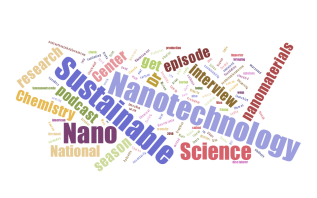
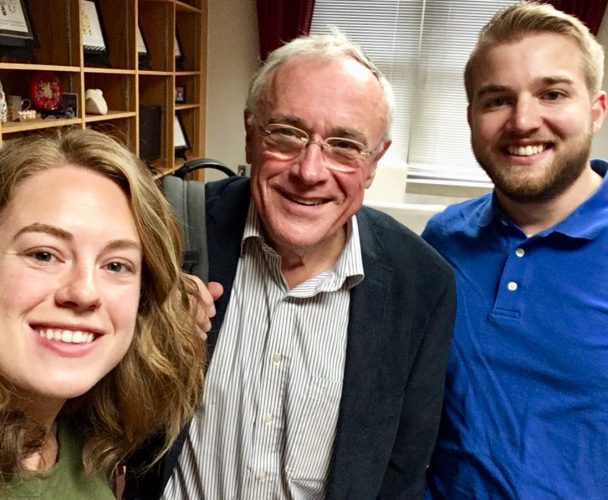
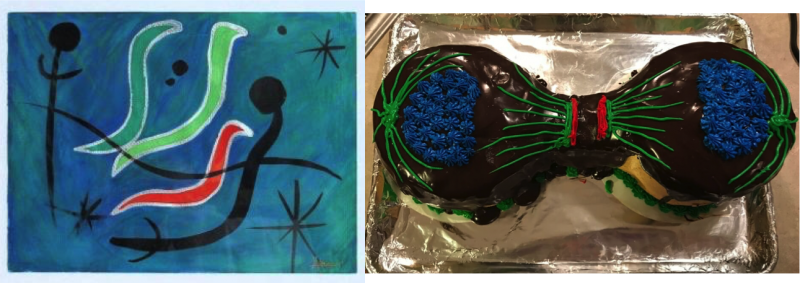
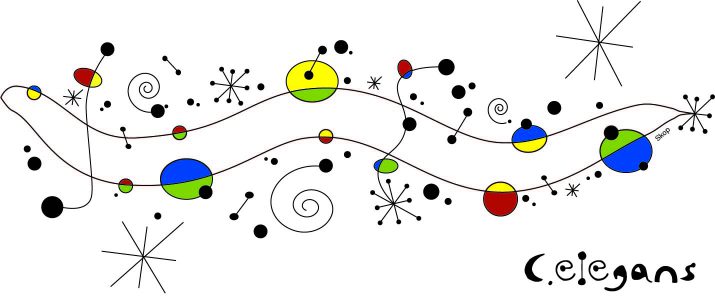
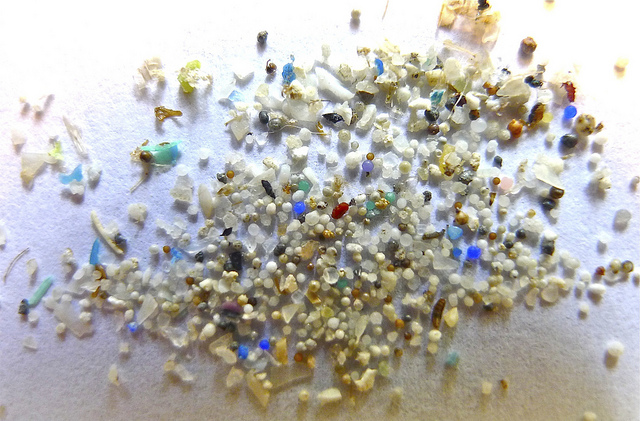 Plastic microbeads (image by
Plastic microbeads (image by 